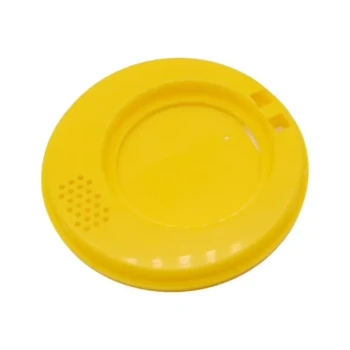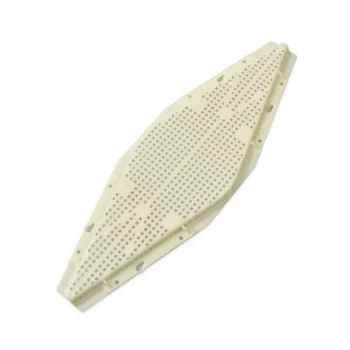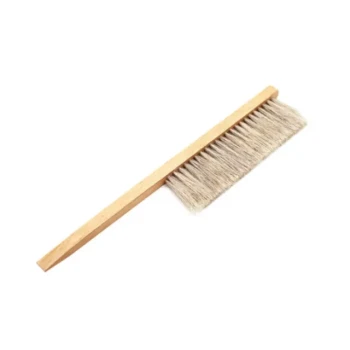In a modern beehive, the primary components directly related to a queen excluder are the brood chamber and the honey supers. The brood chamber serves as the hive's nursery, where the queen lays her eggs. The honey supers are boxes placed above this nursery, intended solely for honey storage. The queen excluder is a purpose-built screen placed directly between these two sections to act as a gatekeeper.
A beekeeper's core challenge is separating honey production from brood rearing. The queen excluder is the key tool for this, creating a physical barrier that confines the queen to the lower brood chamber while allowing smaller worker bees to access the upper honey supers.
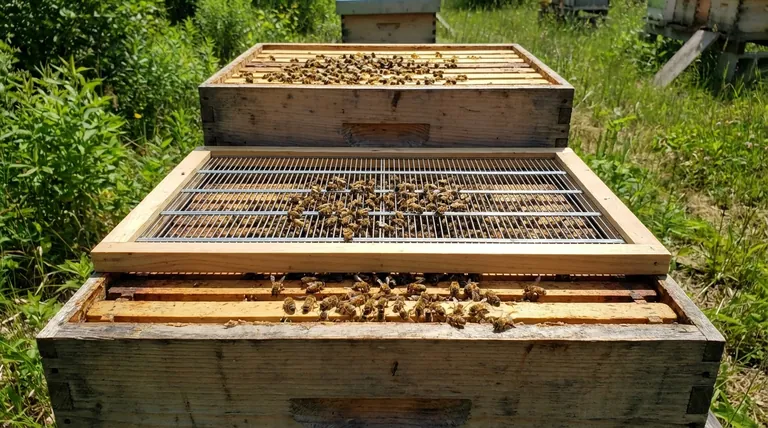
The Core Components of Hive Organization
To understand the excluder's role, you must first understand the functional sections of the hive it divides. The modern hive is a vertical stack, with each component having a distinct purpose.
The Brood Chamber: The Hive's Nursery
The brood chamber, or brood box, is the heart of the colony. It is typically the largest and lowermost box in the hive stack.
This is where the queen lives and performs her primary function: laying thousands of eggs. Worker bees tend to the resulting larvae and pupae (collectively known as brood) in this chamber.
The Honey Super: The Hive's Pantry
Honey supers are smaller, shallower boxes placed on top of the brood chamber. Their sole purpose is for the storage and ripening of honey.
Worker bees will fill the frames within these supers with nectar, which they then process into honey. Because these boxes are intended for harvest, it is critical that they contain only honey, not brood.
The Queen Excluder: The Strategic Divider
The queen excluder is a flat grid made of metal or plastic. The gaps in the grid are engineered to be a specific size.
These gaps are large enough for worker bees to pass through freely but too small for the queen's larger thorax to fit. This effectively traps her in the brood chamber below, preventing her from laying eggs in the honey supers above.
How These Components Work Together
The vertical arrangement of these parts is a deliberate system designed to manage the colony for efficient honey production.
The Standard Hive Configuration
A typical hive is stacked from the bottom up: a bottom board (the floor), one or more brood chambers, the queen excluder, one or more honey supers, and finally an inner cover and top cover for protection.
This structure creates a clear upward path for worker bees. They can move from the nursery to the pantry to deposit honey without interruption.
The Goal: Pure, Brood-Free Honey
By confining the queen, the excluder ensures that frames removed from the honey supers contain only honeycomb and honey.
This makes the honey extraction process vastly simpler and cleaner. There is no risk of damaging larvae or mixing brood into the harvested honey, which improves its quality and purity.
Installation and Placement
The queen excluder must be placed directly on top of the uppermost brood box. The first honey super is then placed directly on top of the excluder.
It is crucial that the excluder lies flat and fits tightly against the edges of the hive body. Any gaps can provide an opening for the queen to bypass the barrier, defeating its purpose.
Understanding the Trade-offs and Pitfalls
While highly effective, using a queen excluder is a management decision with potential downsides that every beekeeper should understand.
Potential for Reduced Honey Flow
Some beekeepers observe that the excluder can act as a barrier that worker bees are hesitant to cross, sometimes referred to as a "honey barrier."
This can potentially slow the rate at which they fill the honey supers. The sharp edges on some metal excluders can also slightly damage bees' wings over time, though this is a point of debate.
Risk of a "Honey-Bound" Queen
If workers are reluctant to move honey up through the excluder, they may begin storing it in the brood chamber instead.
This can "backfill" the cells in the nursery, leaving the queen with less space to lay eggs. A honey-bound brood chamber can limit colony growth and potentially increase the likelihood of the colony swarming.
The Need for Colony Strength
A queen excluder is most effective with a strong, populous colony. A smaller or weaker colony may not have enough foragers to effectively work the space both below and above the excluder, rendering it an unnecessary obstacle.
Making the Right Choice for Your Goal
Applying this understanding allows you to manage your hive with greater precision. Your decision to use an excluder should be based on your specific beekeeping objectives.
- If your primary focus is maximizing pure honey for harvest: Use a queen excluder to guarantee your honey supers are free of brood, which simplifies extraction and ensures high-quality honey.
- If your primary focus is rapid colony expansion: Consider removing the excluder to give the queen unrestricted access to the entire hive, but be aware that you will not be able to harvest "honey-only" frames from these boxes.
- If you notice reduced honey production after adding an excluder: Inspect the hive to ensure the colony is strong enough and not honey-bound, and consider temporarily removing the excluder to encourage movement into the supers.
Ultimately, understanding the function of each component empowers you to configure your hive in a way that best supports the health of your bees and achieves your goals.
Summary Table:
| Component | Primary Function | Relation to Queen Excluder |
|---|---|---|
| Brood Chamber | Nursery for the queen to lay eggs and raise brood. | The excluder confines the queen to this section. |
| Honey Supers | Boxes for honey storage and ripening. | Placed above the excluder to keep them brood-free. |
| Queen Excluder | A grid that acts as a physical barrier. | Placed between the brood chamber and honey supers. |
Ready to optimize your honey production with the right equipment?
As a leading wholesale supplier to commercial apiaries and distributors, HONESTBEE provides durable, precision-engineered beekeeping supplies—including high-quality queen excluders designed for maximum efficiency and bee health. Let us help you build a more productive and profitable operation.
Contact HONESTBEE today to discuss your wholesale needs and discover how our equipment can benefit your business.
Visual Guide
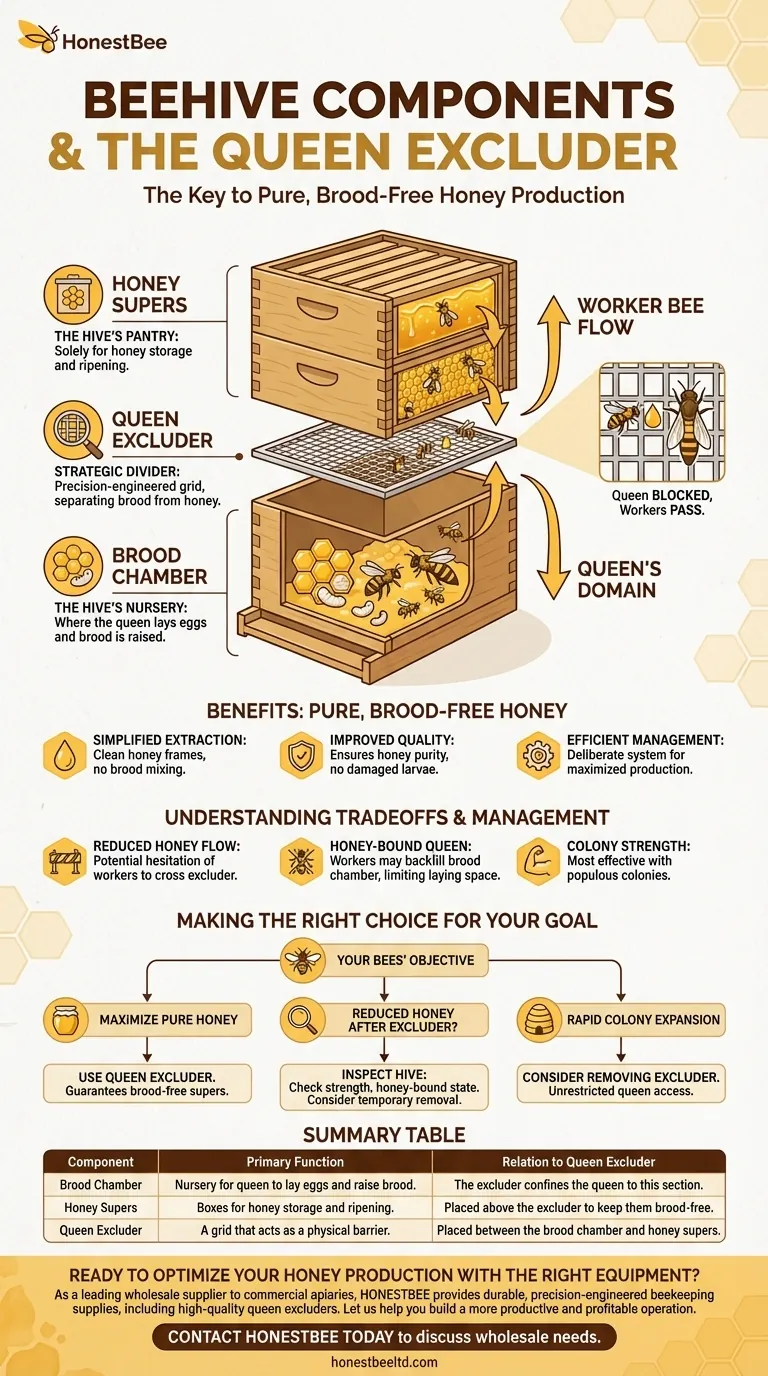
Related Products
- Premium Wood Framed Metal Wire Queen Bee Excluder
- High Performance Plastic Queen Excluder for Beekeeping and Apiary Management
- Professional Plastic Queen Excluder for Modern Beekeeping
- Plastic Queen Bee Excluder for Bee Hive Wholesale
- Wooden Queen Bee Excluder for Beekeeping
People Also Ask
- Where should a queen excluder be placed in a beehive? The Key to Hive Organization
- What is the purpose of a queen excluder? Achieve a Clean Honey Harvest & Organized Hive
- What are the advantages of using queen excluders? Boost Honey Production & Hive Management
- Can a queen get through a queen excluder? A Guide to Preventing Hive Failures
- What makes polyurethane foam environmentally friendly? The Surprising Benefits of a Durable, Inert Material














